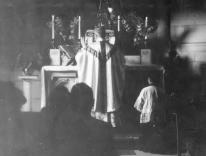The shaking struck on a Friday—not quite the 13th but near enough. I was lying on my bed enjoying my afternoon siesta when everything in my room began to sway this way and that. I’ve become reasonably accustomed to swaying after fifty-five years in Japan, where small earthquakes are fairly common. But this was different. It wasn’t the gentle movement I was accustomed to. It was something I had never experienced, whether here in Japan or back in England. Books and papers began falling all around me, and I remained lying there motionless, waiting for the movement to stop. But for a long time it didn’t stop. When it finally did, I got up and surveyed my room, which was a complete mess. Two bookshelves had fallen over, spilling their contents. I left my room to explore the rest of the Jesuit house where I live. Along the way, I quickly learned two facts about the earthquake. One was that here in Tokyo it had registered a magnitude of 5.5 on the Richter scale, whereas the strongest I had ever experienced in this land of earthquakes had been little over 4. The other was that at the epicenter of the quake, off the coast of Miyagi Prefecture, the magnitude had been 8.8. That was indeed something, more than any of us had thought possible, even in Japan.
And that wasn’t all. There was yet an immense tidal wave—what the Japanese, and now the rest of the world, call a tsunami. Watching it on T.V. rush through coastal towns and adjacent fields, I was appalled. Even more than the earthquake, here was a monster. It seemed to be carrying all before it: cars, houses, and presumably people. We watched as the tragedy grew ever larger. Not only the general movement of the tidal wave, but also the dazed, distressed, speechless reaction of the poor people trying to escape it. The numbers of dead gradually rose from the tens to the hundreds and then to the thousands, with many still unaccounted for, and tens of thousands taking refuge on higher ground. The region hit by the tsunami was largely rural and agricultural: farms, villages, and towns scattered around the growing city of Sendai. I had no friends in that area with whom to communicate or commiserate.
What of the Catholic Church there? One foreign priest had died of heart failure, and one church had been put out of action. But for the most part churches and schools had been wisely built on heights, and so they had suffered little damage. That was a small relief. It’s too early to say how local priests and sisters and laity have been able to respond to the crisis.
Back in Tokyo, what I had experienced in my room was more or less what everyone had experienced. The more books, papers, and loose objects one had, the worse. Fortunately for me and the other Jesuits who teach at Sophia University, it was vacation time, between the all-important entrance exams in February and the beginning of the school year in April. Most of us could stay where we were, watching the TV news like everyone else in the world. From time to time there were aftershocks of a lesser magnitude, but we’ve been warned of the possibility of another massive aftershock, which so far hasn’t come. There remains a feeling of uncertainty, especially concerning transportation, as trains have not been running regularly. So many engagements have had to be cancelled or postponed for safety’s sake. (Since Friday I have had to cancel, or have had cancelled, some five engagements.)
Now, we learn, there is a serious threat of radiation from the explosions at the nuclear plants in Fukushima. What will happen then? I feel like the Old Man in Macbeth, though he was speaking not of an earthquake but of other dreadful portents, “Threescore and ten I can remember well; Within the volume of which time I have seen Hours dreadful and things strange, but this sore night Hath trifled former knowings.” It all makes us pause and think and, above all, pray—for the dead and the bereaved, for those whose homes have been destroyed or who live near the damaged nuclear plants, for the whole country.
Related: Kashima & the Catfish, by Charles De Wolf
After the Tsunami, by the Editors
Resilience, by E. J. Dionne Jr.
Please email comments to [email protected] and join the conversation on our Facebook page.
Share
Previous Story
Alone Again
Next Story
Letter from Tokyo


